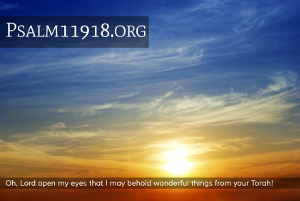The Foundation
Our Services
Interactive Resources
Blog
 Our blog provides the Psalm11918.org contributors with a channel for less formal communications with our readers. Some of our blog entries are about personal events while others are just plain silly and fun.
Our blog provides the Psalm11918.org contributors with a channel for less formal communications with our readers. Some of our blog entries are about personal events while others are just plain silly and fun.
In any case, we hope you enjoy and are blessed everything you find here! :)
- The Psalm11918.org team
If we were to be transported back in time to the first century and were to study “Moses and the Prophets” as Jesus, the disciples, and the two men on the road to Emmaus did (Luke 24:27), what would we learn? What portraits of the Messiah would we find? Come… join our band of believers and study Scripture in the footsteps and pattern of our Lord and Savior.
If we were to be transported back in time to the first century and were to study “Moses and the Prophets” as Jesus, the disciples, and the two men on the road to Emmaus did (Luke 24:27), what would we learn? What portraits of the Messiah would we find? Come… join our band of believers and study Scripture in the footsteps and pattern of our Lord and Savior.
The bedrock foundation of first-century studies included an annual reading of the Torah: Genesis through Deuteronomy. The passages that are studied this time of year are found in the book of Genesis chapters 37:1-40:23. The chapter and verse numbers that we use to identify passages of Scripture today did not exist in the days of the Master. Instead, they identified the weekly passages, known as a parashah (”portion”) by the first word or two of that passage. This week’s parashah is known as Vayeshev (pronounced vye yeh SHEV). This Hebrew word means “and he lived” as it is written in the beginning of our portion:
If we were to be transported back in time to the first century and were to study "Moses and the Prophets" as Jesus, the disciples, and the two men on the road to Emmaus did (Luke 24:27), what would we learn? What portraits of the Messiah would we find? Come… join our band of believers and study Scripture in the footsteps and pattern of our Lord and Savior.
The bedrock foundation of first-century studies included an annual reading of the Torah: Genesis through Deuteronomy. The passages that are studied this time of year are found in the book of Genesis chapters 32:3-36-43. The chapter and verse numbers that we use to identify passages of Scripture today did not exist in the days of the Master. Instead, they identified the weekly passages, known as a parashah (”portion”) by the first word or two of that passage. This week’s parashah is known as Vayishlach (pronounced vye eesh LOCK). This Hebrew word means “and he sent” as it is written in the beginning of our portion:
“Then Jacob sent messengers before him to his brother Esau in the land of Seir, the country of Edom.” - Genesis 32:3 (NASB)
Realizing that this may be a sensitive subject for some who are just beginning their Torah walk, Christmas is the next topic that is examined in the In Support of Torah Observance- Debunking the Myths series. Christmas will be examined in two parts:
Part 1: What does Scripture and history say about Christmas? Part 2: Where do the traditional trappings of Christmas come from?
Part 1: What does Scripture and history say about Christmas?
Scripture
If we search the whole of Scripture in English or the original languages we find no mention of "Christmas". While the birth of Messiah is definitely described in Scripture, it is recorded in only one place: Luke 2:1-7. Examining these verses we find that there is no mention of "Christmas", trees, holly, yule logs, gifts, tinsel, wreaths, Santa Claus, or reindeer. Where did the traditional Christmas come from?
The previous article of this series addressed common myths regarding Sabbath observance for believers. This article will focus on addressing common myths Christians have about food.
God never changes
First we should note that G-d does not change. Ever.
For I, the LORD, do not change; therefore you, O sons of Jacob, are not consumed. - Malachi 3:6
Every good thing given and every perfect gift is from above, coming down from the Father of lights, with whom there is no variation or shifting shadow. - James 1:17
Today is
Yom Sheni, 21 Nisan, 5784 - Chag Hamatzah
Monday, April 29, 2024